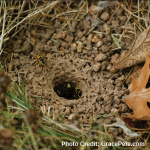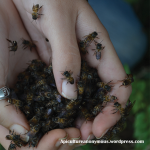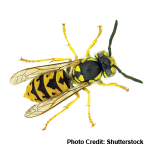I came across an article with research showing most adults have a difficult time distinguishing honeybees from other insects with stingers. I often speak with people who think they have a honeybee swarm for me to come and take, but they are actually dealing with yellow jackets and wasps. I also hear from a lot of people who are afraid of honeybees based off of past experiences with stinging insects. I’d like to talk about the most common insects with stingers and dispel some of the myths about the humble honeybee.
Suspect #1 – The Yellow Jacket
I remember seeing these around more than any other type of bee when I was growing up. One time I even got stung by one and it hurt a lot. Some people also call these wasps, which is technically correct, as they are a type of wasp. The yellow jacket gets its name from its yellow and black bands that cover its body. Two things really separate them from honeybees in my opinion: yellow jackets’ legs are usually all yellow and they do not have any hairs on their bodies. Another difference is the hive the yellow jacket builds. Their nest is round and made of a papery-looking substance.  Yellow jackets are also known to build a nest under ground. If you disturb a nest, my advice is to get away from it as soon as possible and come back later to burn the hive.
Yellow jackets are also known to build a nest under ground. If you disturb a nest, my advice is to get away from it as soon as possible and come back later to burn the hive.
How they are different from honeybees: Yellow jackets are bright yellow, carnivores, they can sting and their venom is painful.
Suspect #2 – The Wasp
Wasps have bodies similar to hornets but have red and brown colors. I haven’t seen these too much in Northern Indiana, but I must say, just looking for pictures online of them made me a little scared. A wasp is technically anything that isn’t a bee or an ant, which leaves a lot of room for ambiguity. They can make hives similar to yellow jackets, but I have seen nests without a cover, as in the picture I have here.
How they are different from honeybees: Wasps are much darker and skinnier. They inject a paralyzing venom into victims and then eat them. Only adults consume nectar. They can live solitary or in a community.
Suspect #3 – The Hornet
 Hornets look like an evil cross between a yellow jacket and a wasp to me, with double the meanness. They can be larger than yellow jackets and wasps, and can be yellow striped and white striped. Their nests look just like yellow jackets’ nests. If you stumble upon a hornet nest, be very aware and get away fast. They have an attack hormone they can use to signal the entire hive against you. Hence why you don’t want to kick a hornet’s nest!
Hornets look like an evil cross between a yellow jacket and a wasp to me, with double the meanness. They can be larger than yellow jackets and wasps, and can be yellow striped and white striped. Their nests look just like yellow jackets’ nests. If you stumble upon a hornet nest, be very aware and get away fast. They have an attack hormone they can use to signal the entire hive against you. Hence why you don’t want to kick a hornet’s nest!
How they are different from honeybees: Hornets are larger and can sting you multiple times. Their venom contains a compound that makes the sting hurt very bad.
Suspect #4 – Carpenter Bees


Let’s move on to some nicer bees after all these scary ones. Carpenter bees are large and fuzzy, and they don’t usually have stingers. However, they can do damage to wood. Carpenter bees build their homes in wood and raise their young in perfect circles they chew out of the wood.
How they are different from honeybees: Carpenter bees are larger, all black or violet and will build their nests in wood.
Suspect #5 – Bumble Bees

 Bumble bees are often called the teddy bears of the bee family. They are gentle giants that like to forage for nectar and pollen in gardens. They are large, very fuzzy and very loud as they buzz by. Bumble bees can produce honey, but often just enough for the queen to make it through the winter. In early spring, you might even be able to find the bumble bee queens buzzing around your yard, they are much larger than workers.
Bumble bees are often called the teddy bears of the bee family. They are gentle giants that like to forage for nectar and pollen in gardens. They are large, very fuzzy and very loud as they buzz by. Bumble bees can produce honey, but often just enough for the queen to make it through the winter. In early spring, you might even be able to find the bumble bee queens buzzing around your yard, they are much larger than workers.
How they are different from honeybees: Bumble bees are much larger and instead of having yellow or orange on their abdomens, they primarily have the color on their thorax (the part just below their head) and black everywhere else.
This is a honeybee:


Honeybees are small and often have striped orange abdomens. They build their natural hives in trees, and their hive looks nothing like a wasp nest. These insects are hard workers and won’t hurt you unless you threaten them or their hive. If they sting you, they die quickly and can no longer help the hive.
How honeybees differ from all the usual suspects: Honeybees tend to be small and go from flower to flower in your yard. They are herbivores and don’t kill other insects unless they are attacking the hive. They are responsible for pollinating 1/3 of the fruits, vegetables and nuts we consume. They are gentle and produce a vast amount of honey for beekeepers. Honey won’t go bad for hundreds of years, it has multiple uses and healing effects.
If honeybees were like wasps and these other suspects, you definitely wouldn’t see beekeepers doing these kinds of things in these pictures. We aren’t necessarily brave, we don’t risk our lives taking care of honeybees, but we are passionate about saving a species we depend on for our own survival.







